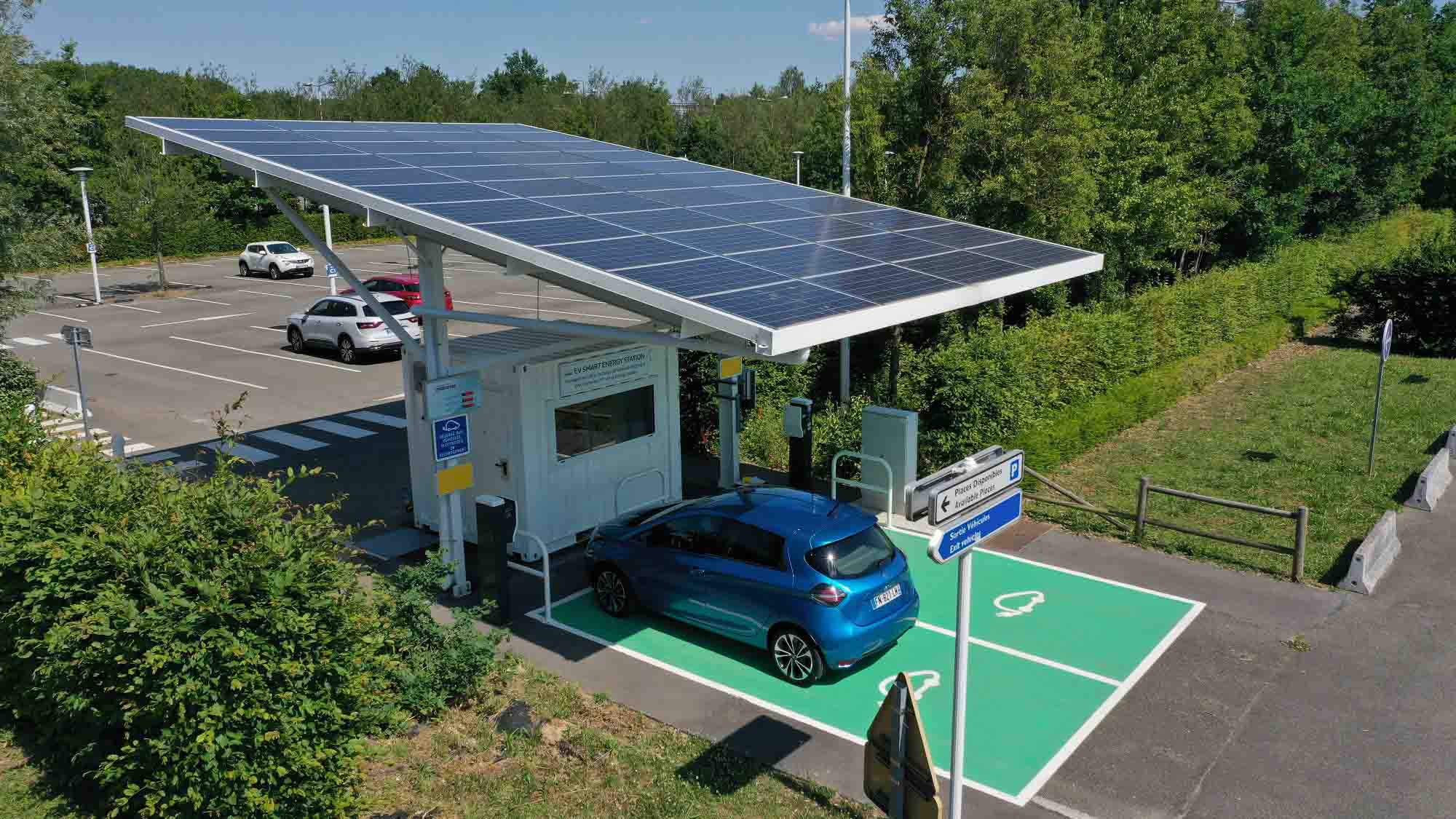Electromobility: sustainable advantages for the environment
The advent of the electric car is a response to a major challenge: to drastically reduce the amount of carbon dioxide and atmospheric pollutants emitted by modes of transportation. This reduction contributes towards improving air quality and, of course, to the fight against climate change.
Objectives set by the Paris Agreement in particular have led the European Union to draw up legislation on the amount of CO2 that a car may produce when driving. Manufacturers like Renault anticipated this paradigm shift a decade ago by developing vehicles run entirely on electricity. It is, to date, the only automotive technology ensuring zero-emission travel* produced on a large scale. Over its entire life cycle, an electric car like Renault ZOE has a lower carbon footprint than its combustion-powered counterpart by almost 40% on average in Europe**. This percentage varies depending on the energy mix used for the production of energy in its geographic location. Low-carbon energy sources (nuclear, solar, wind) help reduce the carbon footprint made from using an electric vehicle.
Clearly of interest for personal-use vehicles, electric mobility is just as relevant for other modes of transport. Battery-powered buses, electric bicycles and small electric motor vehicles (electric scooters, hoverboards etc.) have spread across cities to provide sustainable transportation alternatives. Electromobility also brings about progress in energy conservation on a wide scale. Carsharing, the innovative service that relieves traffic congestion and offers vehicle access to users when they need, increasingly uses electric vehicles. This new function is perfectly compatible with the principal of recharging, as the car can be topped up between rentals. Plus, shared vehicles are used more frequently than personal cars, which optimizes their life cycle.
An increasing number of municipalities and rural communities are choosing carsharing, where vehicles can also be used for carpooling and journeys on-demand. These new modes of mobility reinforce the choice of transport services available, whether private or public. Often electric, they increase the number of zero-emissions journeys and the resulting benefits for the environment.
The electric vehicle also has a key role in “smart grids” or, in other words, intelligent energy logistics. Thanks to its battery, which is used for real-time energy storage, it promotes the production and use of the lowest carbon electricity possible, with suppliers pledging lower tariffs where green energy is available
The electric car is always improving
Range: the challenge to meet users’ needs
To be fully adopted into the automotive market, the electric car adapts to all types of use. While, at the beginning, its range made it suitable for predominantly short journeys, technological advances now take it much further: like Renault ZOE, which can cover 395 kilometers WLTP on a single charge***. And soon, new models will boast a WLTP range of up to 580 km.
For drivers who are looking for a range similar to that of diesel- and gasoline-powered cars, the current hybrid and plug-in hybrid vehicles like Captur E-TECH Plug-in offer both an electric motor and combustion engine.
Constantly improving charging infrastructure
Numerous motorists are looking to make the move over to electric mobility, and having charging points close to their work, home, roadside or company car park is a real game-changer when it comes to purchasing their first electric vehicle. Governments in multiple countries are developing the installation of charging infrastructure to create constantly-expanding national networks. As an example, the French government has announced the objective of reaching 100,000 public charging stations by the end of 2021, with the German federal government estimating that 70,000 stations are required to effectively serve their electric drivers’ needs.
Electricity supply: an angle to explore
In order to further improve the carbon footprint of electric mobility, electricity supply becomes the focus of attention. This is because, depending on the energy mix of a national grid, the production of one kWh may be significantly less carbon-intensive in a country where renewable energies are favored compared to those which rely principally on thermal power stations to produce electricity. This is the reason why current and planned large-scale developments — in Germany for example — of the wind and solar sectors, gives more weight to the ecological argument in favor of electric vehicles. What’s more, the development of smart grid technology optimizes the charging of electric vehicles, which can be carried out when electricity is the least carbon-intensive.
Challenges for the industry
V2G
Also called “bidirectional charging”, and tested by Renault in Utrecht (Netherlands) for example, V2G (vehicle-to-grid) technology looks to be a major innovation in the field of electric cars. It is set to be rolled out on a large scale in the next few years.
Based on the principle of energy storage, it enables the reinjection of electric current from the batteries of vehicles plugged directly into the network. This balances energy supply and demand at all times, especially in the event of intermittent power production — as is the case with wind and solar power. This is a solution to be integrated into future ecodistricts in particular, where renewable energy is produced by wind turbines and solar panels as part of a local distribution channel, but also to larger regions, like cities or islands.
Solar power or electrical induction for wireless charging
What about equipping electric cars with solar panels so that they recharge when stationary, but without needing to be plugged in, as a complement to their high-density battery? This is one of the potential interesting leads being explored at the moment, although it’s early days for the moment.
More mature technically, but requiring additional work in terms of infrastructure, charging via dynamic induction could also increase the range of electric vehicles. Magnetic fields generated under roadway asphalt would be transferred to the car, according to the same principle as the wireless smartphone chargers found on Renault ZOE, for example.
Is Germany the next champion of electromobility?
With its clear political objectives advocating non-polluting vehicles, Germany is a front runner in the electric mobility race. The accelerated roll-out of public charging stations (one charging station per service station in Germany by 2023) and the various purchase aids introduced in recent years herald further growth for a country that already finds itself in the European top spot in terms of electric vehicle sales (in absolute value). Its considerable automotive market gives Germany a strong position among countries driving electric mobility forward.
While the proportion of electric vehicles sold in Germany in 2020 was only 3.7%, this variable is an extremely promising one — doubling in a single year. By comparison, the share of all-electric in new vehicle sales is 7.1% in France, 5.7% in Switzerland and 4.5% in Austria. It could be said, therefore, that it is Europe as a whole, now and moving forwards, which comes out as the champion of electric mobility.
Electromobility: political responses to come
Faced with climate change, the acceleration of the development of electromobility depends on manufacturers like Renault, energy sector bodies and pressure from public authorities. Policies that support the purchase of electric vehicles and the creation of charging infrastructure are a way for governments to reimagine the future of travel. Purchase bonuses, subsidies or tax credits for the installation of charging stations are currently available in France and Germany, for example, following commitments made by public authorities. The future will also see dialogue between manufacturers, consumers and public authorities. In Switzerland, for example, the electromobility roadmap involves 54 organizations working together to ensure that electrified cars represent 15% of cars sold in the country by 2022.
European states and manufacturers are coming to the same conclusion together: the fight against climate change involves a transition to green energies. A transition for which the electric vehicle is one of the most immediate drivers…
* Neither atmospheric emissions of CO2 nor pollutants while driving (excluding wear parts).
** According to the French “Le véhicule électrique dans la transition écologique” (The Electric Vehicle as Part of the Energy Transition), carried out in 2017 for the Foundation for Nature and Mankind.
*** WLTP: Worldwide Harmonised Light Vehicle Test Procedure. The standard WLTP cycle corresponds to 57% of city journeys, 25% of suburban journeys and 18% of motorway journeys.
Copyrights: Jonasre (Adobe Stock), Elexent


